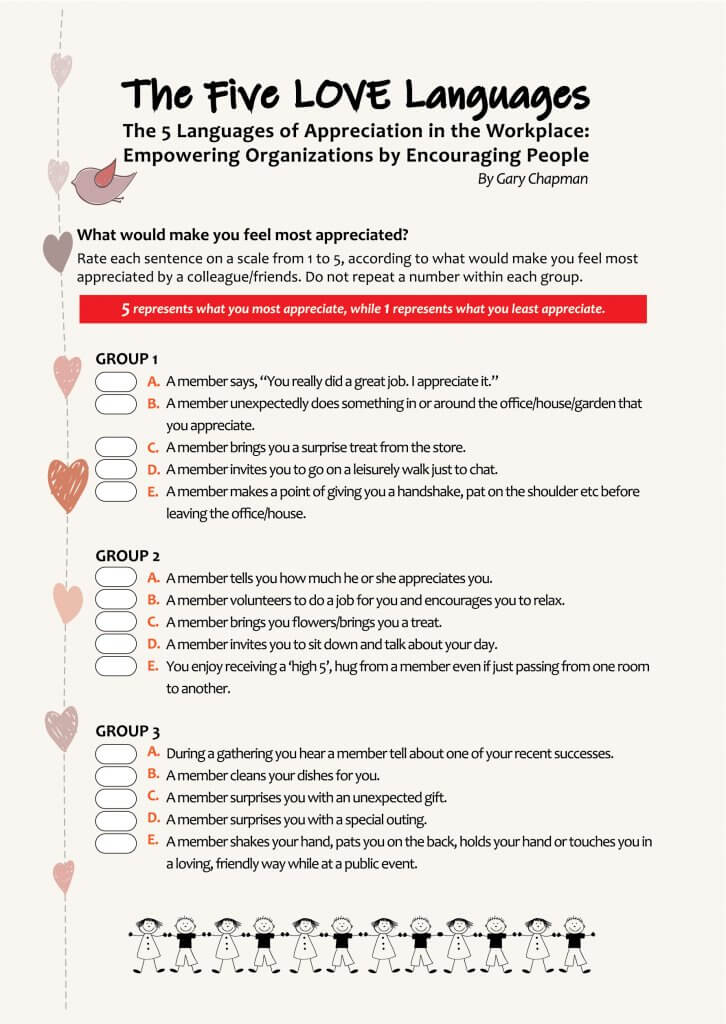Hey there! You ever heard of the 5 love languages? It’s a concept created by Dr. Gary Chapman that has been helping couples and individuals understand their needs and those of their loved ones for decades now. But did you know it’s not just for adults in romantic relationships? The 5 love languages can also be applied to children and even in the workplace! Let’s dive deeper into this topic and explore how you can use it in your everyday life.
The Basics
 The 5 love languages are: Words of Affirmation, Quality Time, Receiving Gifts, Acts of Service, and Physical Touch. These are basically the ways in which people show and receive love. It’s important to note that everyone has a primary love language, meaning the way they prefer to receive love, and a secondary love language, meaning the way they also appreciate receiving love.
The 5 love languages are: Words of Affirmation, Quality Time, Receiving Gifts, Acts of Service, and Physical Touch. These are basically the ways in which people show and receive love. It’s important to note that everyone has a primary love language, meaning the way they prefer to receive love, and a secondary love language, meaning the way they also appreciate receiving love.
For example, your primary love language might be receiving Words of Affirmation, such as compliments, encouraging words, and appreciation. Your secondary love language might be Physical Touch, such as hugs, kisses, and holding hands.
Applying it to Children
 Understanding your child’s love language can help you deepen your bond and create a more loving and supportive relationship. Here’s a breakdown of the 5 love languages and how they can be applied to children:
Understanding your child’s love language can help you deepen your bond and create a more loving and supportive relationship. Here’s a breakdown of the 5 love languages and how they can be applied to children:
Words of Affirmation
Children who prefer Words of Affirmation might respond positively to hearing things like “I’m proud of you,” “You did a great job,” or “I love you.” They appreciate verbal praise and recognition for their achievements.
Quality Time
Children who prefer Quality Time appreciate undivided attention from their parents or caregivers. This means putting away phones and other distractions and spending time talking, playing, and doing activities together.
Receiving Gifts
Children who prefer Receiving Gifts appreciate thoughtful gestures and presents. It doesn’t have to be anything big or expensive, but something that shows you were thinking of them and care about their happiness.
Acts of Service
Children who prefer Acts of Service appreciate when their parents or caregivers take care of things for them. This can be as simple as making them breakfast or helping them with homework. It shows them that you want to help and support them.
Physical Touch
Children who prefer Physical Touch appreciate cuddles, hugs, and hand-holding. It helps them feel safe, loved, and supported.
Applying it to the Workplace
 The 5 love languages can also be applied to the workplace, helping to create a happier and more productive staff. Here’s how:
The 5 love languages can also be applied to the workplace, helping to create a happier and more productive staff. Here’s how:
Words of Affirmation
Employees who prefer Words of Affirmation appreciate recognition and compliments for their hard work and achievements. It boosts their morale and makes them feel valued.
Quality Time
Employees who prefer Quality Time appreciate one-on-one interactions with their superiors or colleagues. This allows for deeper connections and a better understanding of their needs and strengths.
Receiving Gifts
Employees who prefer Receiving Gifts appreciate bonuses, incentives, and other tangible rewards. It shows that their efforts are recognized and appreciated.
Acts of Service
Employees who prefer Acts of Service appreciate when their superiors or colleagues lend a hand or help them out when needed. It shows a willingness to support one another and work together as a team.
Physical Touch
While Physical Touch is not necessarily appropriate in a professional setting, employees who prefer this love language may appreciate a high-five, pat on the back, or handshake as a form of recognition or appreciation.
The Quiz
 Want to know your love language? Take the quiz! It’s a series of questions that will help you understand which love language resonates with you the most.
Want to know your love language? Take the quiz! It’s a series of questions that will help you understand which love language resonates with you the most.
Remember, everyone’s love language is different and it’s important to understand both your own and those of your loved ones in order to create a more harmonious and loving relationship. So whether it’s with your partner, your child, or your colleagues, take the time to learn about each other’s love languages and watch your relationships thrive.
The Takeaway
 The 5 love languages are a powerful tool for improving relationships in all aspects of life. Understanding your own love language and those of others can help you communicate better, show love more effectively, and create deeper connections. So take the time to learn about the 5 love languages and start applying them to your everyday life. Your relationships will thank you for it!
The 5 love languages are a powerful tool for improving relationships in all aspects of life. Understanding your own love language and those of others can help you communicate better, show love more effectively, and create deeper connections. So take the time to learn about the 5 love languages and start applying them to your everyday life. Your relationships will thank you for it!